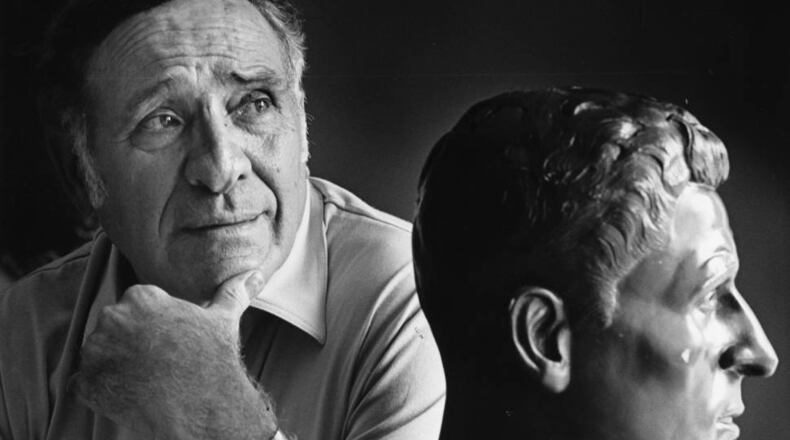A panel of AJC voters chose these players as the top 10 Georgia football players of the 1940 and 1950s. The players are listed alphabetically.
Harry Babcock
An end during the one-platoon era of college football, Babcock earned All-American and All-SEC honors in 1952 and led the conference in receptions with 41 (for 666 yards) in 1951. Georgia’s all-time leading receiver when he graduated, with 80 catches for 1,199 yards and five touchdowns, Babcock became one of five No. 1 NFL draft picks produced by the Bulldogs when San Francisco selected Babcock first overall in 1953.
Zeke Bratkowski
Bratkowski doubled as the Bulldogs’ quarterback and punter in the early 1950s. Bratkowski led the nation in passing in 1952 and in punting in 1953. He left UGA in 1953 owning most of the school’s passing records. A second-round draft pick of the Chicago Bears, Bratkowski would achieve greater team success in the NFL. He played on back-to-back Super Bowl champions with the Green Bay Packers in 1966-67. After retiring, Bratkowski embarked on a 26-year career as an NFL quarterbacks coach and offensive coordinator. He was inducted into UGA’s Circle of Honor in 2006.
Charley Britt
Britt split time with Fran Tarkenton at quarterback. But the more memorable plays of his UGA career almost all came on defense and special teams and many of them against archrival Florida. That was especially true in the 1959 game against the Gators in ankle-deep mud in Jacksonville. Britt returned a punt 26 yards to set up his own 35-yard TD pass to Robert Towns, returned an interception 100 yards for a touchdown, and ran down a Florida player after a 70-yard gain at the 2, where the Bulldogs would hold fast on goal-line stand. Georgia won 21-10 in a pivotal win that helped secure the SEC title.
Johnny Carson
Another great end for the Bulldogs, Carson earned All-American honors when he led the nation in receptions (46) in 1953. Carson’s name often gets left out of conversations about Georgia’s better overall athletes of all-time, but probably shouldn’t. He was a rare four-sport letterman in college, earning them in football, basketball, baseball and golf. Was a first-round draft selection of Washington and played seven NFL seasons. Inducted into UGA’s Circle of Honor in 2003.
Pat Dye
Dye would become much better known for his association with Auburn as head coach, but well before that he was a standout player for the Bulldogs. Dye starred at offensive guard and linebacker, earning All-American in both the 1959 and ‘60 seasons. Known for having a “nose for the football,” Dye once stole the ball from a Kentucky player on a kickoff return and took it 28 yards for a Georgia touchdown. Against Auburn in 1959, he recovered a fumble at the Tigers’ 35, which set up the game-winning TD pass that would clinch the SEC title.
Credit: AP
Credit: AP
Johnny Rauch
Rauch is one of a very rare commodity among Bulldogs – a four-year starter at quarterback. He started 45 consecutive games under center from 1945-48, which was one of Georgia’s more successful runs. Often pairing up with the great Charley Trippi in that era, the Bulldogs went 36-8-1. Rauch was named SEC player of the year in 1948 when Georgia went 9-1 and won the SEC championship. Rauch became a successful NFL coach. He was 33-8-1 with the Oakland Raiders, leading them to the Super Bowl in 1967.
Theron Sapp
Known as the “Drought Breaker,” Sapp became a legend among Bulldogs for scoring the only touchdown in a 7-0 win over Georgia Tech in 1957. That victory snapped an eight-game losing streak to the Yellow Jackets, thus the moniker that would follow Sapp the rest of his life. What many have since forgotten is that the winning TD was just one of many great plays he made in that game. Playing middle linebacker, he also recovered a Tech fumble at midfield that set up an almost all-Sapp scoring drive. Two years later, Sapp would become the third Bulldog to have his jersey retired. No one has worn the No. 40 since. Sapp played fullback for the Philadelphia Eagles and Pittsburgh Steelers, winning an NFL championship with the Eagles.
Credit: AJC file photo
Credit: AJC file photo
Frank Sinkwich
Sinkwich became Georgia’s first Heisman Trophy winner in 1942. That year the Bulldogs went 11-1 and won their first consensus national championship. Sinkwich accounted for 60 touchdowns – 30 rushing and 30 passing – as a three-year starter for the Bulldogs. He set the SEC rushing record with 1,103 yards in 1941 and then established the total offense record with 2,187 yards the next season. Known as one of Georgia’s toughest players of all time, he played the 1942 national championship game with two sprained ankles and scored the only touchdown in 9-0 win over UCLA in the Rose Bowl. He played most of that season with broken jaw in an innovative new helmet that included a specially designed chinstrap.
Credit: Tracy O'Neal/AJC
Credit: Tracy O'Neal/AJC
Fran Tarkenton
Considering his accomplishments at Georgia – and certainly later in the NFL – it’s hard to believe that Tarkenton was not an every-game starter for the Bulldogs most of his career. But he was on the field for some of the biggest moments in school history. That includes throwing the winning touchdown pass to Bill Herron with 13 seconds remaining to beat Auburn 14-13 and capture the 1959 SEC championship. Tarkenton also led the Bulldogs to a 14-0 win over Missouri in the Orange Bowl to cap that season, then led the SEC in total offense as a senior in 1960. Tarkenton would go on to play 18 NFL seasons with the Vikings and Giants. He was inducted into UGA’s Circle of Honor in 1998.
Charley Trippi
Trippi is hard to beat in an argument over the greatest athlete ever to wear the red and black. Not only did he star on the national championship team of 1942, but after missing the 1943 and ‘44 seasons and half the ‘45 season while serving with U.S. armed forces during World War II, he came back to lead the Bulldogs to an undefeated 1946 season (11-0) that ended with a win over North Carolina in the Sugar Bowl. He won the Maxwell Award as the nation’s top back that year but finished as runner-up to Army’s Glenn Davis for the Heisman Trophy. Also a standout baseball player, Trippi batted .475 with 11 home runs in 30 games for the Bulldogs in 1946. Simultaneously, he was the No. 1 pick of the NFL’s Chicago Cardinals, while baseball’s New York Yankees, Boston Braves and Philadelphia Phillies all jockeyed to sign him. Trippi chose football, accepting a record $100,000 deal from the Cardinals, then hit .334 in 106 games playing minor league baseball for the Atlanta Crackers. He’s in the College Football Hall of Fame and the Pro Football Hall of Fame.
Credit: Tracy O'Neal/AJC
Credit: Tracy O'Neal/AJC
About the Author
Keep Reading
The Latest
Featured








